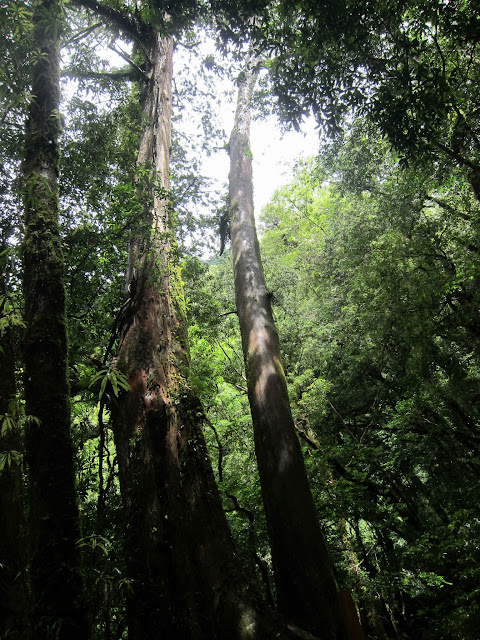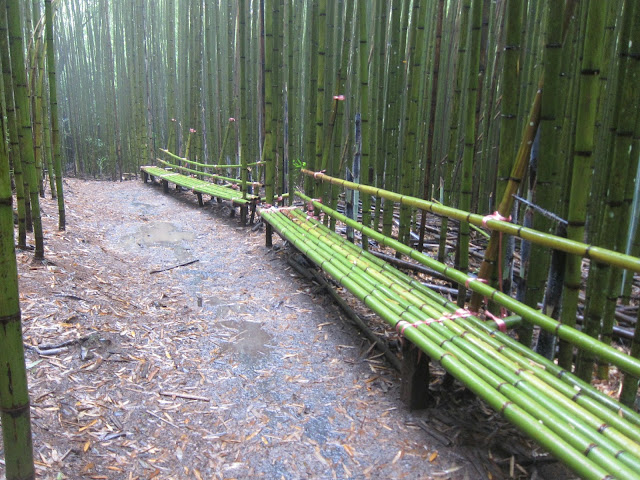Smangus - Mother of Cypress
The next early morning, we woke up with the misty mountains of Smangus.
After the breakfast, we took a bit rest and then departed for the trees at around 8:30am. The entry to the forest is at the north end of the village after you walk passing the watchtower and Qegiy (the Trees of Husband and Wife). It takes just 10mins walk to the entry.
Ruma, Pinhaga, and Gong Sknux
The morning rain (or perhaps "shower") had eased off after the breakfast, and the hiking trail is not steep at all. But the drizzle still made everything muddy and made our walk clumsy.

The first vegetation we encountered was the famous thick bamboo forest of Smangus, also called Ruma in Atayal.

To say one plant best describing the exotic impression of Chinese culture, that would be bamboos. Walking along the winding trail squeezed by the mixed woodlands of makino bamboo and moso bamboo was just a feast. It was such a pleasure to be surrounded by the jade green bamboos while listening to the raindrops falling on the bamboo trees!
To make the benches with the bamboos was just a convenient way for the tribal people to make good use of the resources surrounding them.
After walking 1 km, we saw a sign by the trail, learning that the area is called Gong Sknux, which means "The Stream of Smell". This was because the aboriginal people used to keep the animals they hunted in the cool stream water nearby as the best natural refrigerator, and, as a result, the stream always sent out the smell of the animals. However, we did not smell anything there, though :)
Trakis
 |
| A scooter by the trail. |
Millet ('trakis' in Atayal) is one of the most important crops probably among all the Taiwanese aboriginal tribes. While each tribe has its own story or mythology about millets, Atayal people tend to connect the crops to the origin, the prosperity, and the succession of life.
 |
| The view from Mita Kayal, a new tourist toilet on the
way to Yaya Qparung.
|
Yaya Qparung
After 1.5 hr walk, finally we came to Yaya Qparung -- Wait, not yet!
Yaya Qparung actually means Mother of Cypress, and we in fact just arrived at the area of the 9 big trees of Smangus and Yaya Qparung is a bit deeper within the forest.
There are 9 giant trees in the area. From the 1st one to the 8th, which is the biggest giant tree, the Yaya Qparung, it takes only 15 mins.
 |
| Yaya Qparung |
Yaya Qparung is 20.5m in girth and 35m in height. There is another giant tree in the area with 19.7m in girth. And the two giant trees are ranked as the 2nd and the 3rd biggest trees in Taiwan as of 1996.
According to Taiwan's official definition, a tree of more than 2,000 years old is called a Super Devine Tree (超級神木), one between 1,000 and 2,000 years old called a Devine Tree (神木), and then a Giant Tree for a tree of between 500 and 1,000 years old. As Yaya Qparung is estimated of being around 2,500 years old, it should be dubbed as a Devine Tree. However, since trees don't have spirits for the Atayal people (and neither do Sun, Moon, stones, and other plants), unlike some of other tribes, they prefer to call it a Giant Tree.
'Yaya' means "mother" in Atayal, and "qparung" means cypress, and so the biggest tree is named. The discovery of this giant tree forest was not an accident nevertheless. In 1991, Smangus' tribal head Mrhuw Icyeh and other Smangus' people visited Balung in Taoyuan (where some giant trees were discovered -- actually Balung means "giant tree" in Atayal) and learnt giant trees can improve local people's living standard. And then, at one night, Icyeh heard a voice in dream (Spi), saying that Smangus could be as popular as Balung in the future, and the ground would shake because a large number of visitors would come to Smangus. He and other people therefore started to look for giant trees when they went back to Smangus. Over 2-3 months, they eventually found the Formosan cypress forest as the giant tree forest nowadays, which attracts thousands of tourists coming to the remote tribe annually.

I was standing at the wooden fence surrounding Yaya Qparung, awed by the astounding creation in front of me -- not knowing it was because of its beauty or its solemnity... No aer i Naneth Gelaidh!
This is the first time I saw giant trees in my life -- Yaya Qparung is not very tall, compared to the other giant trees in the rest of the world. However, the story that the native aboriginals set off for seeking for the forest in spi ("dream"), the ancient wisdom they have to protect the trees and to deliver the knowledge and the gaya ("the ancestors' words") of the Mother Nature to the next generation, all making the forest and the thousand-year giant trees more fascinating.

The delightful mountain stream and the valley of the Snow Mountains -- thanks to the sun coming out!
 |
| On the way back to the tribe, we were lucky to see a sunny day and the wide landscape of the beautiful millet farms shining in the sun. |
 |
| Ashtray |
 |
| "Smangus" |
 |
| The hero Makus carrying a mortar for millets. His name is one of the origins of Smangus.. |
 |
| The artwork depicts an Atayal couple with the traditional tattoos on the faces. |
 |
| The church we hung around last night. |

We wanted to take a walk to Koraw Ecological Park near the tribe after visiting Yaya Qparung. Koraw means "the fertile soil/land" in Atayal. As the area is facing west and has less sunlight, it is more humid and much darker than the hiking trail we just walked in the east.
We tried to make our way to the park but in vain, as there were too many forks without any clear sign telling where to go. We finally gave up so as to drive back to Taipei by the night.
The picture was taken in Mar, 2005 (and was not taken by me of course!) when there was a cold current coming to Taiwan, resulting in a heavy snowfall in the village where the snow depth reached 40-50cm!
This is to say, I'll definitely want to go back to Smangus again in winter to see this quiet and remote beauty in person!
References














1 comment:
Hi, Thanks for the lovely review. Can Smangus be done in one day? We will be from Hsinchu City.
Post a Comment